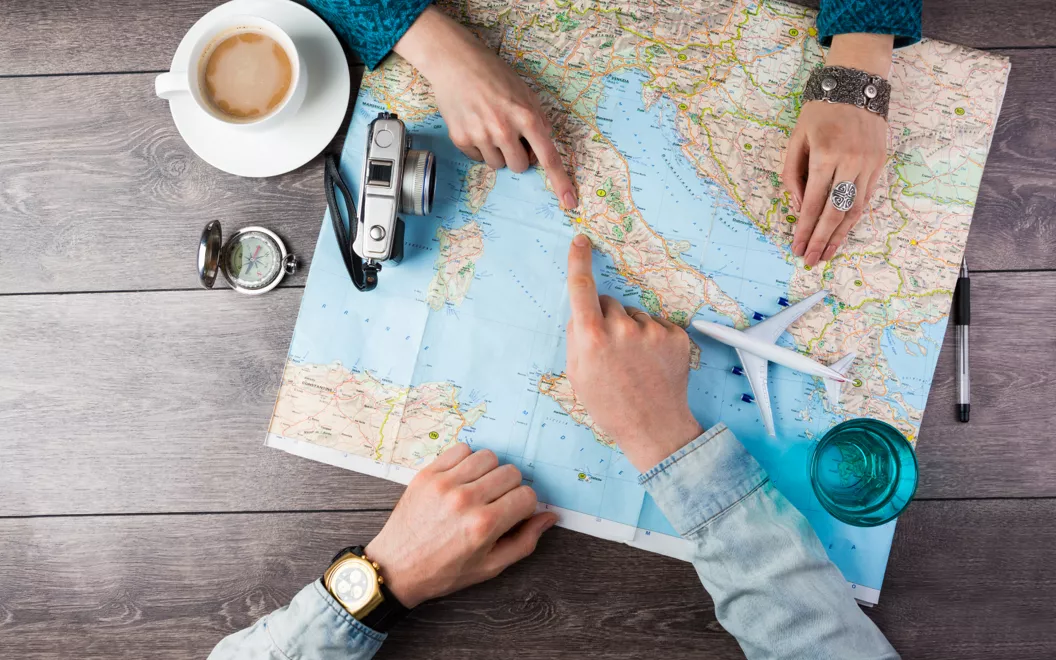How to travel to Italy
4 minutes
By plane, to travel to Italy from all over the world
Around 40 airports throughout Italy offer a tight network of domestic, international and intercontinental flight connections.
The main entry hubs are the international airports, in particular the Rome–Fiumicino International Airport “Leonardo da Vinci” and Milan Malpensa Airport. However, there are also plenty of other Italian airports served by international connections.
Thanks to the services of traditional and low-cost airlines, a wide range of flights is available, covering a large number of destinations. You can find more information on routes, timetables, prices and availability by visiting the websites of the major airlines.
How to get from the airports to the city centre Plenty of connections are provided by taxis, buses and trains, making it easy to reach your final destination.
Travelling to Italy by train from all over Europe
The extensive and comprehensive European railway network that connects Italian cities to other capital cities makes it possible to travel directly to an Italian city centre.
We recommend making the most of the international EuroCity trains, which connect several European cities, with a wide choice of timetables and routes.
If you prefer to travel at night, an equivalent service is offered by the EuroNight trains, on which you can sleep for the duration of your journey.
Travelling to Italy by car or motorbike for road trips
The extensive European motorway network and several passes all along the Alps make it easy to travel to Italy by car or motorbike: you can travel from Austria, France, Switzerland or Slovenia.
The main crossings and tunnels in Italy open all year round are:
- the Mont Blanc Tunnel: from Chamonix, it connects France to the A5 motorway to Turin and Milan;
- the Frejus Road Tunnel: this connects France to the A32 motorway to Turin;
- the Great St Bernard Tunnel: which connects Switzerland via the Strada Statale 27 to the A5 motorway to Turin and Milan;
- the Brenner Pass through Austria joins the A22 motorway towards Bologna.
Please note that the tunnels through the Alps are often closed during the winter and, due to snow, sometimes also in the autumn and spring.
For real-time information, you can visit the websites of Autostrade per l’Italia and Anas.
Travelling to Italy by coach from all over Europe
You can also travel to Italy from all over Europe by coach, along the routes that have always connected Italy to the rest of the continent. There are plenty of line agencies that run this kind of road trip, including newer budget companies, which can offer this service at very affordable prices.
Travelling to Italy by ship from all Mediterranean ports
Thanks to its more than 8,000 kilometres of coastline, dotted with numerous ports, there are plenty of opportunities to travel to Italy by sea. Before setting off, you may find it useful to research crossing times and international routes that include stopovers at Italian ports, operated by Italian and international shipping companies.
Ticket prices are higher in summer and vary according to its size if you are travelling with a means of transport (e.g., a car or motorbike).
The main shipping company websites to find out more information and buy tickets for your trip include:
- Grimaldi Lines - which connects Greece, Spain and Tunisia to Italy.
- GNV: Grandi Navi Veloci - which connects Morocco, Tunisia and Albania to Italy.
- Blue Star Ferries - which provides connections from Greece: from Igoumenitsa, Corfu and Patras directly to Ancona, Venice and Bari.
- Tirrenia Navigazione - which connects Tunis and the main Italian islands, Sicily and Sardinia.
Not to be forgotten:
Customs controls in Italy
Before arriving in Italy, it is important to remember that customs regulations set specific limits and restrictions, particularly with regard to importing specific goods, e.g., food, alcohol and tobacco products, as well as cultural goods and pharmaceutical products.
The amount of cash, including coins and banknotes, you are permitted to take with you is also subject to restrictions: you can take up to EUR 9,999.99 to Italy without having to declare it. Above this amount, you have to fill in a specific form at the relevant offices so as not to incur penalties and seizures ranging from 30% to 50% of the amount exceeding the indicated limit.
There are also precise rules regarding what personal belongings travellers may bring, the transport of goods of animal and plant origin, and bringing pets into the Italian territory.
You also have to respect these directions for entering Italy when leaving, whether for your home country, another European country or any other destination.
For more details, you can check the Travellers’ Customs Charter.


